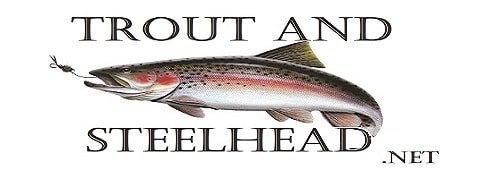Float Fishing In Pennsylvania: Tactics and Tips
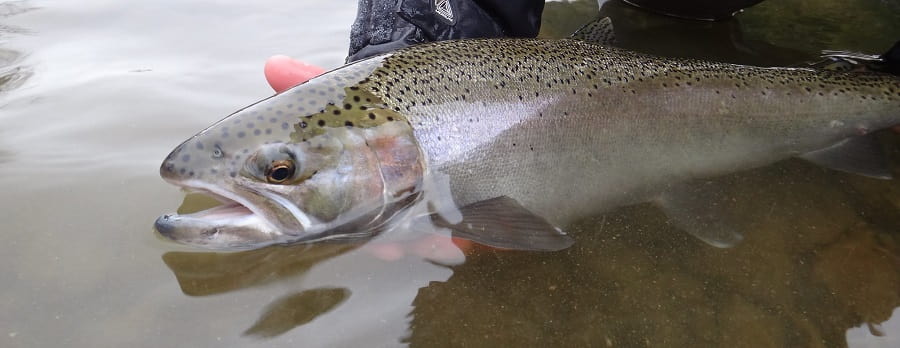
Float fishing Pennsylvania streams is often the most effective method if the river is over 3 feet deep, which is why so many PA anglers choose this method over all other stream fishing methods.
I have been float fishing for over 30 years with spinning reels and Centerpin reels, so I can confidently say that when float fishing is done well, with the right floats and the right leader setup, it’s very hard to beat.
There are five key fundamentals I teach in my classes and on guide trips, and these should be used on all PA streams.
- Speed Control
- Depth Control
- Presentation
- Bait Selection
- Set-up
Learning to read the water and be stealthy and out of sight of the fish is also a must.
Why Float Fish PA Streams
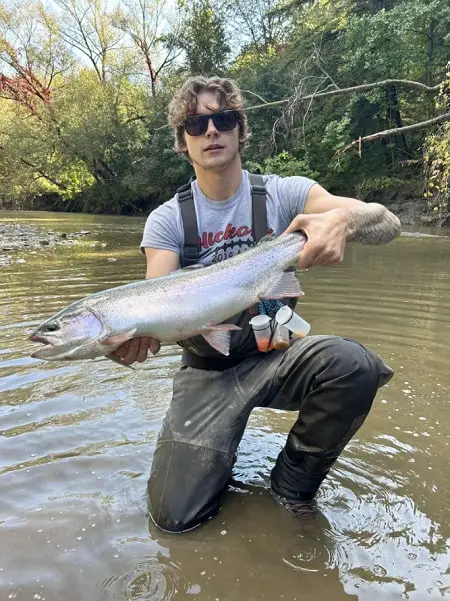
Pennsylvania has many great steelhead and trout rivers large enough for float fishing.
Float fishing works well because of the ability to keep your bait suspended above the fish’s heads and in the strike zone for extended periods. You can make long drifts, and you can also stay far back from the fish.
Great float fishing anglers have also learned to control the speed of the float, which dramatically improves the amount of fish you can catch.
It doesn’t matter if you are float fishing, or whether you fish for steelhead, salmon, or trout; there are things I do and that I teach my clients that greatly increase the amount of fish they catch.
Once you understand these simple float fishing tips and tricks, I believe you can catch ten times more fish and do it more consistently.
About Float Fishing In Pennsylvania?
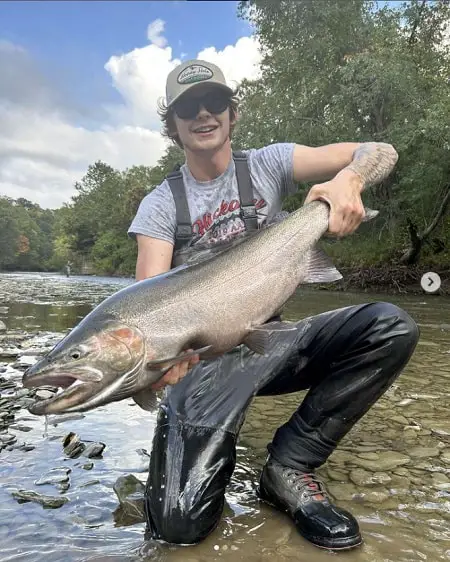
You will see anglers float fishing in PA, mostly for steelhead, but some anglers also fish resident trout with floats.
You will also have a tough time finding guides that offer float fishing since most guides prefer to fly fish. Younger generation guides like Dalton Moose from Moose’s Steelhead Guide Service offer float fishing with spinning reels and Centerpin reels.
As simple as float fishing might seem, most anglers do it poorly.
A List Of Pennsylvania Rivers You Can Float Fish
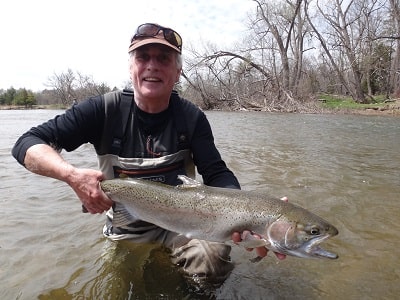
All Pennsylvania rivers are suitable for float fishing if they have areas with depths greater than 3 feet.
If the water is deeper than 3 feet deep and is shallower than 13 feet, it is optimal for float fishing.
Sections under 3 feet deep, especially if it is very clear water, the float can spook the fish, and therefore, in this type of water, or in tiny pockets less than a few feet long, I will switch to bottom bouncing methods or fly fishing. See Low Clear Water Steelhead Fishing Tips and Tactics.
Best Steelhead Rivers In Pennsylvania
- Elk Creek
- Walnut Creek
- Twenty Mile Creek
- Conneaut Creek
- Steelhead Alley (includes various tributaries such as Trout Run, Crooked Creek, and Sixteen Mile Creek)
- Godfrey Run
- Cascade Creek
- Four Mile Creek
Best Trout Rivers In Pennsylvania
- Delaware River
- Susquehanna River
- Lehigh River
- Penns Creek
- Allegheny River
- Juniata River
- Lackawanna River
- Schuylkill River
Reels For Float Fishing
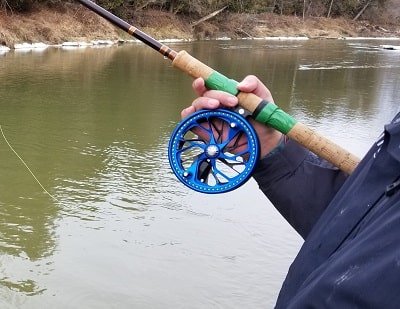
If you are planning on float fishing, one of the most important things you will need is the right kind of reel. Some reels are better than others for the float fishing method, and there are three you can choose from.
Generally, the commonly used types of float reels for fishing with float are centerpin reels and spinning reels. Some anglers will also use open-face baitcasting reels.
Centerpin Reels Are Best For Float Fishing
A Centerpin reel is a large round spool that sits on a center pin or post, giving it its name, the Centerpin. The Centerpin reel is also commonly called a float reel.
Centerpin reels are characterized by their extremely high-quality bearings that allow for the free spool of the reel and line as the current pulls the float down the river. The angler merely controls the speed of line coming out with slight pressure on the reel if it starts spinning to fast.
Using a centerpin reel makes very long, precise drifts much easier than other reels without mending or feeding the line out. This greatly improves your ability to keep your bait in the strike zone for longer, control your leader angles, control your bait speed, which improves your success.
Based on about 30 years of experience using Centerpin reels and comparing them to spinning reels and even baitcasting reels, I can honestly say that the Centerpin reel is the best reel for float fishing in any river.
Spinning Reels For Float Fishing
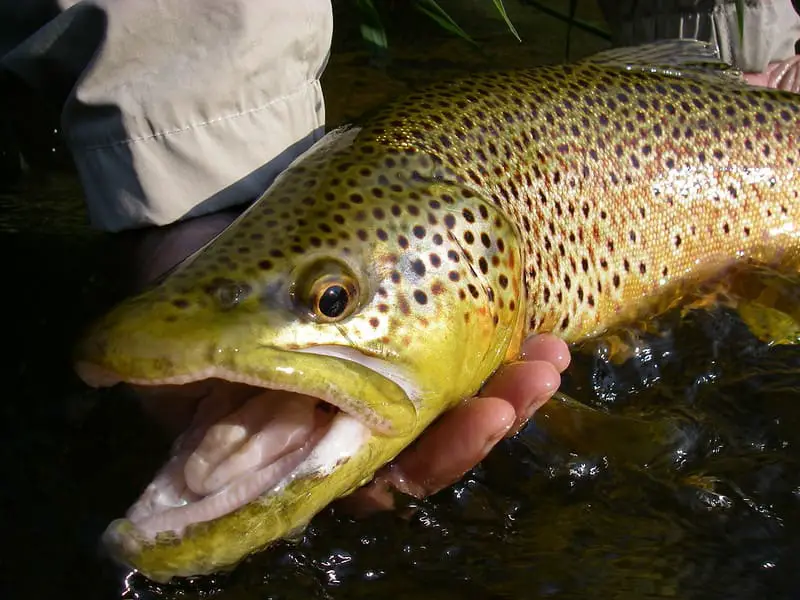
Spinning reels are, in my opinion, the second-best reel for float fishing, yet they are by far the most popular reel for river fishing. I only use a spinning reel if my clients insist or if I need a multipurpose reel for other methods, such as lure fishing or drift fishing.
Even though the line does not come smoothly off the spinning reel compared to a Centerpin reel, with practice, the spinning reel still maintains a good presentation and long drifts.
The spinning reel you use should also match the size of the river and the size of the fish.
I recommend a spinning reel of size 25 or 30 (2500 to 3000) for most steelhead rivers or a size 20 for small stream trout.
Float Rods
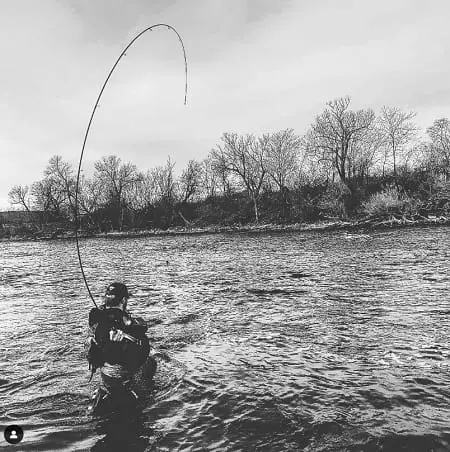
The importance of float rods in steelhead and trout fishing cannot be overemphasized. You use the rod to get a good presentation and fight big fish so the rod is important for your float fishing success.
To increase your chances of success on the river, you want to ensure that your float rod has the right length, power, and stiffness for where you intend to fish and the size of the fish you fish for.
Whether for centerpin or using a spinning reel, long rods between 10 to 14 feet are best, and my go-to size when I am guiding is 13 feet. I will even use long 10-foot rods in small streams less than 15 feet wide.
The size of the river you’ll be fishing will determine the length of your rod. However, the long rod improves your presentation by enabling you to keep the line up and off the water.
The long rod also protects light leaders, which are often necessary on most Pennsylvania rivers. A general rule is the larger the river, the longer the rod.
Basic Float Fishing Rig
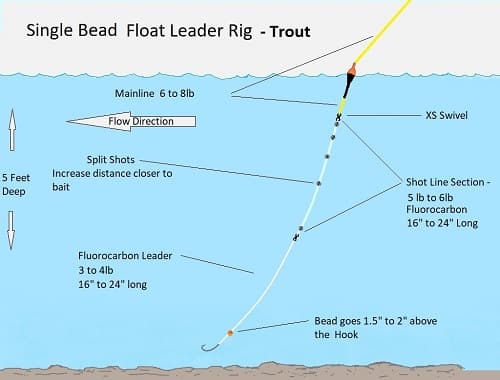
Below is what you are going to need for the float fishing setup. There are plenty of ways to set the leader up, but I recommend my tested and proven float leader setup.
It’s relatively easy to make if you have all the right parts, which I’ll discuss below. I can’t stress enough how important some of those parts are to ensuring success, so if you mickey-mouse this leader with the wrong parts, you will struggle to catch fish.
Hooks
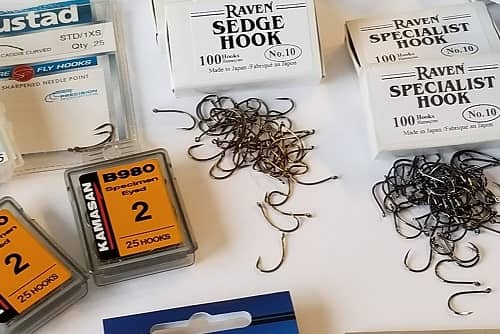
This is one piece of gear that is often overlooked by many anglers, although it is a critical part of the leader. Using the right hooks will go a long way in improving your success.
Some hooks are not effective, and using the wrong hook obviously means catching fewer fish.
I only use the best hooks that I know will penetrate better on the hook-set and will hold on better with fewer fish coming off.
I and other guides use only 5 or 6 types of hooks, but to keep it simple, my top two recommendations for float fishing hooks, which can be found in most stores, are the Raven Specimen Hook and the very popular Gamakatsu Octopus Hook.
The choice of your hook size will depend on the different water conditions, the size of the fish, and the size of the bait.
As a rule of thumb, bigger hooks will be suited for bigger baits, and smaller hooks for smaller baits and smaller fish. However, I’ve caught plenty of large steelhead on small baits with very small hooks.
Generally, a size 8 or 10 hook will work for most Pennsylvania rivers and for both trout and steelhead. I probably use size ten more than any other size. At times, especially with very small baits like a single salmon egg, I will use a size 12 hook.
Just keep in mind, the smaller the hook, the less it hooks up and the more likely it will dislodge from the fish’s mouth during long battles.
Leader Line
When it comes to leaders, you need to find a middle-ground leader and change based on conditions and fish size.
I use a leader so light that the fish do not see it, which gets my clients a lot more bites, yet I know the leader needs to be heavy enough that the larger fish do not keep breaking off.
Through years of experience, this is what I have found to be best in Pennsylvania streams for different species:
- Trout Fishing: 3 to 4-pound leader
- Steelhead Fishing: Clearwater, smaller rivers: 6 pounds (0.18mm) Best general purpose leader: 8 pounds (0.20mm) Large rivers, fast currents, large steelhead: 10 pounds (0.22mm)
- Salmon Fishing: Very clear water and small streams:10 pound (0.22mm), General purpose: 12 pounds (0.24mm), Fast water and large rivers: 14 pounds (0.25mm)
I only use fluorocarbon leaders, and I use two sizes on my leader setup.
There are two sections (the shot line section and bottom section) of the leader setup, and you will need two different leader sizes. As a rule of thumb, the shot-line leader should be about two sizes heavier than the lower leader size.
Swivels For Float Fishing
Sometimes the line will twists during line retrieval. The swivel prevents undesirable tangling of the line, which can lead to line weakening.
The Best Floats For Rivers
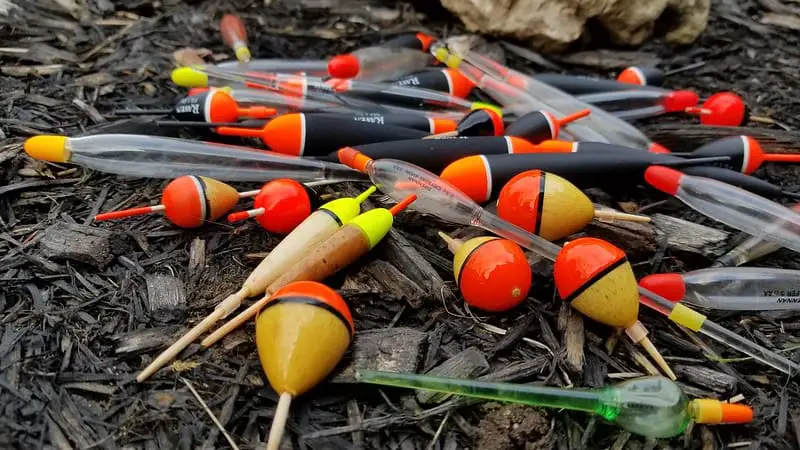
A float is the center of floating, as suggested by its name. Not all river floats are created equal, and some floats perform better while others fall short. Avoid round floats and use thin floats with a pointed top.
The right river float will help you control your speed(which is critical) as well as gauge your depth (by detecting the bottom), Help you detect bites easily, and ultimately catch more trout, steelhead, and salmon.
You need a float that is suitable for the type of water you intend to fish, considering the depth and size of the river. This means both shape and size. My go-to floats are:
In water deeper than my rod is long, I switch to a slip float, which, if set up properly, enables me to fish spots even over 20 feet deep. Otherwise, when float fishing in water 3 to 10 feet deep, I always use what is known as a fixed float.
- Drennan Loafer Floats: Best for clear water and slow water
- Raven FM Floats: Great for most situations.
Float Size: For deeper, faster water that requires more weight, use a bigger float. 8 to 16 grams. 16 grams float would be suitable for very large rivers like the Niagara River. For most PA rivers, I prefer a 4-gram to 6-gram float.
There are some other factors I consider when deciding on the right float. You can learn more about choosing the best floats for your float fishing by checking out my page on “5 Best Centerpin Floats”.
Split Shots / Weights
I only use round split shots that are dark in color. I do NOT use shiny weights or ones with little removable wings. At times, the shiny ones can spook the fish. At other times it can attract them, and they will bite the weight, which you don’t want.
You want subdued weights that won’t take the attention away from the bait.
Best Baits
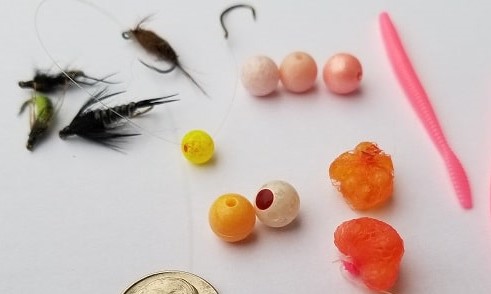
There are a lot of baits that anglers use and many baits that anglers should not, like corn, marshmallows, and some artificial baits.
However, guides are selective and have narrowed down the most effective and consistent baits for trout, steelhead, and salmon.
These are baits they use 95 percent of the time, ignoring the less effective baits.
I choose my baits based on the conditions, and at certain times of the year or under specific water conditions, a normally effective bait might not be as successful.
For this reason, I always have multiple baits with me. If I select a bait and it doesn’t work, I rotate through different baits, different sizes, and colors to figure out which ones are going to trigger a strike response.
Consider these Proven float fishing baits:
- Salmon Eggs and Trout Eggs: At certain times of the year, this is an effective bait for trout, steelhead, and salmon.
- Worms: Worms are generally effective in spring, but they can also be effective all year round.
- Artificial Flies: Artificial flies, the kind fly fishermen use, can be effective at any time of the year, and at times, they are the most effective.
- Live baits: This can include insects like crickets, hellgramites, stoneflies, beetles, mealworms, grubs, minnows, leeches, crayfish, etc.
- Artificial baits: This can include plastic imitations of the above baits as well as baits like Powerbait Doughs.
Tips To Catch 10 Times More Fish When Float Fishing Pennsylvania Streams
There is a simple formula for success when it comes to float fishing, and if you mess up even part of it, you will struggle to catch fish.
A well-presented bait dramatically improves the possibility of a hookup, but the same goes for each part of the formula. If other parts of the formula are wrong, even an excellent presentation can be ineffective.
If your presentation is perfect, which many claim is the key to catching fish, but you use a hook that is too big for the bait and the trout see it, you will struggle.
If your presentation and hook are perfect, but the leader is too thick and is visible to the fish, you will also struggle.
Even if you have the perfect setup and you have the most effective bait, and you have a great presentation, if the speed of your bait is wrong, or the depth of your bait is wrong, you will struggle to catch fish.
What I’m saying is that each part of the formula for good float fishing needs to be perfect for the other parts to be as effective.
I’ve often emphasized that speed control is the most critical part of your presentation, and I say this from experience.
I discuss speed control, depth finding, how to set your float depth, as well as baits and leader setups on the following pages:
Fishing Rules and Regulations
If you are going to fish, you should know things like how many baits you can have on your leader, do you need a fishing license or a tag for steelhead, trout, or salmon, what rivers are open, and when can you legally fish them.
Check the rules and regulations on your State DNR website.
Tight Lines,
Graham
